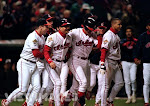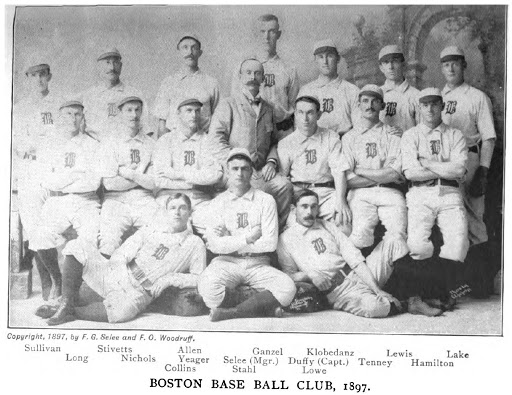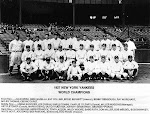The "Alternative-1916" regular season finished this morning with a meaningless game between Buffalo and St. Louis to determine who would finish in 6th place in the NL. The defending champion Boston Rustlers are looking for their unprecedented third consecutive World Series win, with the Chicago White Sox looking to avenge last year's loss. But I'm here to talk about the Yankees.
I managed basically* every inning of every Yankees game this season, and of course I made most decisions. I let the AI handle finances and eventually let it handle the transactions. It started out handling promotions/demotions before I took that over. I have a good sense of how the individual stats worked out, and of course an excellent sense of the overall narrative, but only an iffy sense of the team stats.
Overall, this was a disappointing season for the Yankees. There was definitely a learning curve about all sorts of things though, so hopefully if nothing else I'm setting myself up to handle things better. But at the start of the season, coming off 90+ wins and 3rd place, I was not expecting to have the Yankees in 7th and consider myself lucky to finish at 82-80. I'll try and give my impressions before looking at the stats in more detail to see if those impressions are correct...
Season Narrative: Started well enough, and things really went south a few months in before the team rallied a bit and then played terribly in August. We lost way, way too many games to bad teams. We'd have stretches of 12 games against the teams in 8th, 9th, and 10th, and win 5 of them. We got beaten 19-0 by a terrible Kansas City team that lost 20 games in a row to other teams immediately after wiping us out. We got hit by a spate of injuries and found ourselves 4 games below .500 in early September before recovering and finishing as well as we did. As an aside, in this universe we'd clearly be in a footnote about how the race for the batting title ended--Wally Schang of the A's had a several-point lead over Ty Cobb going into the final series but we kept Schang to 1 for 10 while Cobb went 7 for 10 in his last three games to handily take the title.
Position Players: I feel like the position players, at least in terms of batting, mostly did ok to better than ok. Pipp had a great year, leading the league in home runs and batting about .300, and will probably get some MVP votes. Heilmann really blossomed and would have had a great chance to lead the league in hits if not for his late-season injury. Oscar Charleston got eased into things via some pinch hitting and then occasional starts, but had taken over regular left field duties before too long. Baker had a nice bounceback year and was up at .320 before cooling off and ending up at .290 or so when injury ended his year. Frank Gilhooley did much better than I was expecting in center field, the catchers did fine (especially Nunamaker) and threw out a ton of baserunners, and Birdie Cree was a great 10th man. Baumann was ok. Peckinpaugh somehow lead the team in WAR despite batting about 20-30 points below what I was expecting. Elmer Miller did fine, and it's no dishonor to have lost your starting job to someone often considered one of the best 5-10 baseball players of all time.
Pitchers: This was the real problem, I think. Plank came down to Earth in a serious fashion--he was in the running for the Cy Young Award in 1915 but I can only assume that being on the wrong side of 40 led to his steep decline. We picked up Chief Bender, but after a reasonably good start he hit a rough patch he never got out of. Ray Fisher was awful. Caldwell was hurt all year. Alan Russell was the one bright spot, winning 23 games. He'll clearly get some Rookie of the Year votes. We picked up Babe Adams and Pat Ragan from Brooklyn for Fritz Maisel (who was having a terrible year and not starting), and while Adams did all right Ragan was up and down and found himself in the bullpen. Bender and Fisher ended up in the reserves. Mogridge was all right until our awful August, part of an overall relief pitching problem we had--I don't know how many games we lost in the 8th and 9th, and how many of those were 3+ run leads, but it seemed like an awful lot. I made the big changes just as we were turning things around (not sure whether there's cause and effect or not), I figured the cake was basically baked and I might as well see if Dazzy Vance was ready to join the staff or not. Vance did all right, mostly in relief but with one start in the season's penultimate game.
Defense: Maddeningly bad. I think we actually were middle of the pack with defense, but it felt like we made 2 errors per game more often than zero, and they were always at the worst possible times. I recognize this is confirmation bias, but we had a 7 error game. Eddie Plank wasn't good, but I feel like he was always down 5-0 or 6-2 because the team had given up 3-4 unearned runs. Harry Heilmann was an absolute butcher in right field, as mentioned above. The bright spot was that we threw out a ton of people trying to steal second. I'm giving myself partial credit since a great many of them were on pitchouts that I called.
Injuries: Compared to 1915, 1916 was mostly injury free other than losing Caldwell's season early on until the wheels suddenly came off near the end of August. Baumann was hurt, which meant Cree now was pressed into being a starter. Then, Baker was hurt, which meant Boone had to play 3rd base every day. Then, Heilmann was hurt, so Miller got a starting job again in right field. Then Miller got hurt and Cree moved to the outfield. At that point, Allie Watt was the starting 2nd baseman at 16 years old. Watt's first start, though, was at 3rd base when Peckinpaugh was too tired to play and Boone, our only other shortstop, moved over and we had nobody who could play 3rd base. So Watt's first career major league start, at 16 years old, was at a position he had never played before. Amazingly, this was after the team had started to turn things around in terms of winning.
Meta Issues: As I've mentioned here before, the butterflies have already started to flap. In real life, every AL pennant of the 1910s went to the A's (1910-11, 1913-1914), the Red Sox (1912, 1915-1916, 1918), or the White Sox (1917, 1919). The White Sox seem to have shown up early in this simulation, perhaps in part because the A's didn't fully tear down--the 1916 A's were one of the worst teams in real-life history, but they finished with 90 wins in 3rd place in Alt-1916. With some of the players that fueled Boston in 1915-1916 still with Philadelphia, the White Sox' window opened early (maybe?) and the Red Sox' late-decade window may not open at all. There's no particular reason to think that that's going to change, and some of the pitchers who I would have liked to have on my staff went elsewhere because I didn't understand the draft or the way that player development was going to work (maybe I still don't). We've got excellent pieces for a great team (especially as we get toward 1920) but I can't imagine we're going to get Babe Ruth.
Plans for 1917: I should probably delay details until I've looked at the stats. I've signed Cannonball Dick Redding as a free agent, we'll see if he can help. Vance will help. But I missed out on Shocker, Hoyt, and Pennock in last year's draft. On the other hand, it turns out I had Bill Terry in my reserves as a pitcher. I'm going to see if he can play second base, otherwise he'll be heir apparent to Pipp in the early 20s or maybe I'll have an outfield of Heilmann, Charleston, and Terry...
*The reason it's only "basically" is because during a particularly frustrating game in a particularly frustrating stretch I simmed out the last 3 innings of a game rather than play through it. My headcanon is that I got myself ejected.























